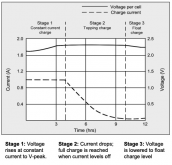Ok, I have read a number of discussions hear on charging parameters for Lithium Iron Phosphate but none really answer my questions. Hopefully, someone can succinctly answer them.
First, as I understand it, LifePO4 batteries should be charged at a constant voltage. No need for the three stage charging I have done with AGM. Is this correct?
Secondly, if that is the case and I want to charge my 12v LifePO4 battery pack to 90%, what voltage should my charging systems by set at? First the AC charger (if I can get a charger to charge at a constant voltage only) and secondly, my MPPT charge controller.
It seems universal that if one stays in a discharge range between 10 and 90% of SOC that battery life will be optimized. How is this best accomplished using both methods of charging indicated above?
Thanks in advance. Any links on the subject appreciated.
First, as I understand it, LifePO4 batteries should be charged at a constant voltage. No need for the three stage charging I have done with AGM. Is this correct?
Secondly, if that is the case and I want to charge my 12v LifePO4 battery pack to 90%, what voltage should my charging systems by set at? First the AC charger (if I can get a charger to charge at a constant voltage only) and secondly, my MPPT charge controller.
It seems universal that if one stays in a discharge range between 10 and 90% of SOC that battery life will be optimized. How is this best accomplished using both methods of charging indicated above?
Thanks in advance. Any links on the subject appreciated.



